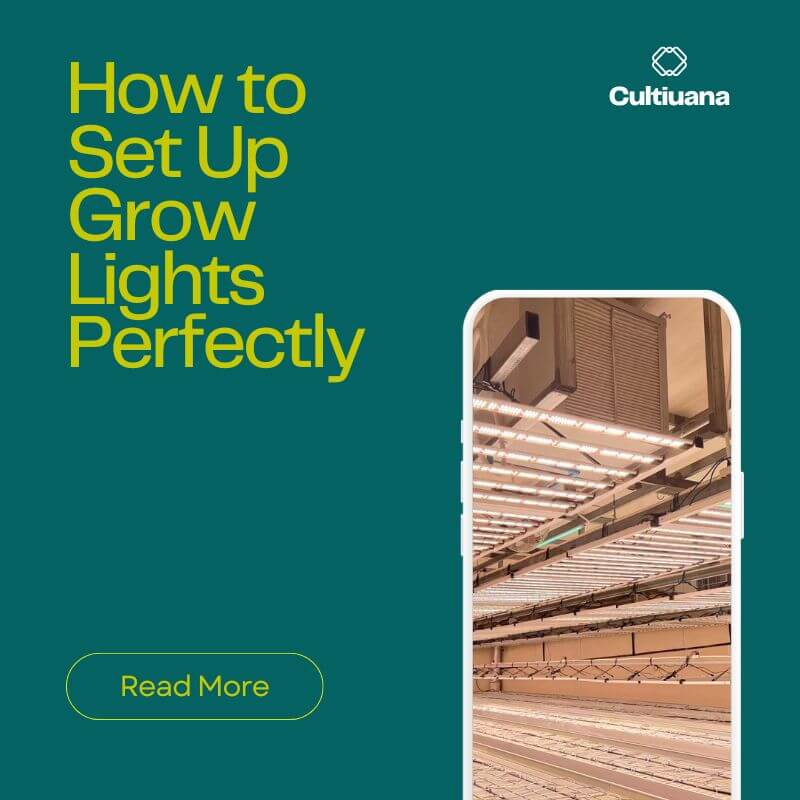
How to Set Up Grow Lights Perfectly
Setting up your grow lights at the right height and preventing light leaks is crucial for an indoor garden. Here are some simple tips on getting it right:
Getting the Light Height Just Right
Having your grow lights at the perfect height is super important. The best way is to use a special light meter tool. But if you don't have one of those, here's what to do:
First, check the instructions that came with your LED grow lights. The manufacturer should recommend an ideal height to hang the lights, or have a diagram showing the heights to use.
If the lights can't be dimmed, hang them at least 25% higher than the recommended height. This gives you room to lower them later if needed. It also leaves extra space above for the dangling cords.
Once your plants are growing, just watch them carefully. If they seem unhappy or aren't growing well, you may need to raise or lower the light height a bit.
If the company that made your lights can't provide any advice on mounting heights, it's probably best to buy lights from a different brand that can give you those important instructions.
For dimmable grow lights, the mounting height still matters. You may be able to dim excessively bright lights, but think twice if you're having to dim them way down, like over 50%. If so, you likely bought lights that are too powerful and wasted money.
Eliminating Light Leaks
For plants that need complete darkness at night, your grow room absolutely must block out every little bit of light.
Cover up any windows using foam insulation boards or something thick that stops light. Use foam weatherstripping around door frames to seal up gaps when the door is closed.
If your grow space is a big room, make a little hallway or "vestibule" area just inside the main door. That lets you open the outside door without letting any light into the main room.
Don't forget about letting light in through air vents! Either use a zigzag PVC pipe shape that light can't pass through, or buy special darkroom vents designed for photography rooms.
Paint the inside of any homemade light traps with flat black paint so light can't reflect around the corners.
How to Mount Lights for Easy Height Adjustments
These tips are ideal for small hobby gardens or testing sections in larger grow rooms:
As mentioned, using the right mounting height is super important. Follow the manufacturer's height recommendations if you don't have a light meter.
For non-dimmable lights, hang them roughly 25% higher than advised. This gives you room to lower them if needed, plus space for cords and such above.
If a grow light brand can't advise you on mounting heights at all, that's a red flag - find a different brand to buy from.
Even for dimmable lights, don't buy ones that are way too powerful if you'll just be dimming them down past 50% most of the time. You're wasting money on excess brightness you don't need.
Using Perforated Angle Iron
Here's a neat trick to avoid having to re-drill holes constantly when adjusting your light heights:
Use perforated angle iron hung from the ceiling or high on walls. This is a long strip of thin metal bent into an L-shape, with holes punched along its length every inch or so.
Mount several strips of this angle iron across your grow area's ceiling using sturdy anchors and screws that can hold up the weight.
Then you can hang your grow lights at whatever height using the pre-made holes in the angle iron strips. Just secure the lights using chains, carabiners, or tough zipties threaded through the holes.
Now you can easily test out different hanging heights by moving the lights up or down on the angle iron - no need to constantly drill new holes! Just make sure to use very secure hangers when mounting heavy lights this way.
Following these tips will help you dial in that perfect bright spot for your indoor garden! Let me know if you have any other questions.
Getting the Light Height Just Right
Having your grow lights at the perfect height is super important. The best way is to use a special light meter tool. But if you don't have one of those, here's what to do:
First, check the instructions that came with your LED grow lights. The manufacturer should recommend an ideal height to hang the lights, or have a diagram showing the heights to use.
If the lights can't be dimmed, hang them at least 25% higher than the recommended height. This gives you room to lower them later if needed. It also leaves extra space above for the dangling cords.
Once your plants are growing, just watch them carefully. If they seem unhappy or aren't growing well, you may need to raise or lower the light height a bit.
If the company that made your lights can't provide any advice on mounting heights, it's probably best to buy lights from a different brand that can give you those important instructions.
For dimmable grow lights, the mounting height still matters. You may be able to dim excessively bright lights, but think twice if you're having to dim them way down, like over 50%. If so, you likely bought lights that are too powerful and wasted money.
Eliminating Light Leaks
For plants that need complete darkness at night, your grow room absolutely must block out every little bit of light.
Cover up any windows using foam insulation boards or something thick that stops light. Use foam weatherstripping around door frames to seal up gaps when the door is closed.
If your grow space is a big room, make a little hallway or "vestibule" area just inside the main door. That lets you open the outside door without letting any light into the main room.
Don't forget about letting light in through air vents! Either use a zigzag PVC pipe shape that light can't pass through, or buy special darkroom vents designed for photography rooms.
Paint the inside of any homemade light traps with flat black paint so light can't reflect around the corners.
How to Mount Lights for Easy Height Adjustments
These tips are ideal for small hobby gardens or testing sections in larger grow rooms:
As mentioned, using the right mounting height is super important. Follow the manufacturer's height recommendations if you don't have a light meter.
For non-dimmable lights, hang them roughly 25% higher than advised. This gives you room to lower them if needed, plus space for cords and such above.
If a grow light brand can't advise you on mounting heights at all, that's a red flag - find a different brand to buy from.
Even for dimmable lights, don't buy ones that are way too powerful if you'll just be dimming them down past 50% most of the time. You're wasting money on excess brightness you don't need.
Using Perforated Angle Iron
Here's a neat trick to avoid having to re-drill holes constantly when adjusting your light heights:
Use perforated angle iron hung from the ceiling or high on walls. This is a long strip of thin metal bent into an L-shape, with holes punched along its length every inch or so.
Mount several strips of this angle iron across your grow area's ceiling using sturdy anchors and screws that can hold up the weight.
Then you can hang your grow lights at whatever height using the pre-made holes in the angle iron strips. Just secure the lights using chains, carabiners, or tough zipties threaded through the holes.
Now you can easily test out different hanging heights by moving the lights up or down on the angle iron - no need to constantly drill new holes! Just make sure to use very secure hangers when mounting heavy lights this way.
Following these tips will help you dial in that perfect bright spot for your indoor garden! Let me know if you have any other questions.




